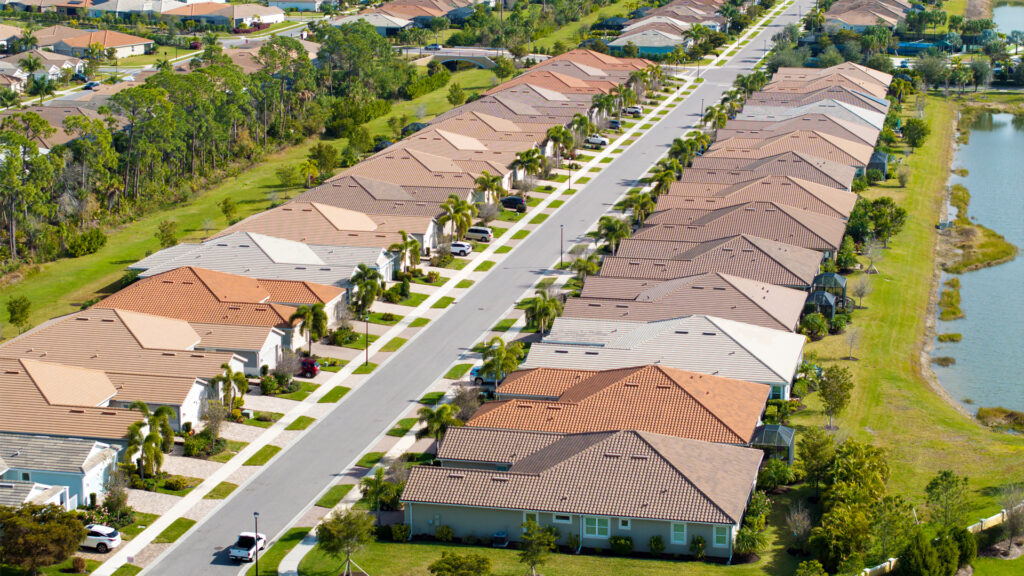By Vivian Young, 1000 Friends of Florida
Many Floridians follow the mantra that any growth is good growth. After all, new suburban development and strip shopping centers bring an influx of construction jobs and short-term revenue to often cash-strapped communities.
Growth is viewed as a way to fill local government coffers quickly. It often is approved with little, if any, fiscal evaluation.
While new development does generate new property and sales tax revenue, does this offset the short- and long-term costs of new development? If the new development is low density, the answer is no.
The geo-accounting firm Urban3 helps local governments understand their communities’ fiscal health by considering the potency of different development patterns from a property-tax value perspective. As we compare automobiles based on the miles they can travel per gallon, Urban3 compares the revenue generated per acre of development with what a community’s taxpayers need to pay for the infrastructure to support the development.

In its recently released report, “The Economics of Development in Florida,” Urban3 concludes:
- Low-density suburban development does not produce enough tax revenue per acre to pay for its infrastructure liabilities, making it fiscally insolvent over the long term.
- By contrast, denser, walkable, mixed-use development patterns produce far more tax revenue per acre than is needed to pay for their associated infrastructure.
Why is this the case?
Property tax accounts for about 75% of revenue for Florida’s city and county governments, and denser development generates more property tax per acre.
In Nassau County, the compact 83-acre Amelia Park generates $2.6 million per acre in property tax. A comparably sized area in the sprawling Will Hardee Road Neighborhood generates only $1.5 million per acre.
Comparing sales tax revenue, downtown Gainesville in Alachua County generates $94,000 in sales tax per acre, while outlying areas only average $48,000 per acre. These fiscal patterns repeat in community after community.
Looking at the cost side of the ledger, Urban3 finds that low-density suburban development does not generate enough tax revenue to cover the costs for its roads, water, sewer, stormwater and other infrastructure and services which need to extend further in low-density areas. Simply put, less infrastructure is less expensive.
Additionally, calculations must include the longer-term maintenance, repair and eventual infrastructure replacement costs. Urban3 found that in Hillsborough County, low-density suburban areas in Wimauma are five times more costly than low-density rural areas.
Denser communities have other benefits as well. They can better support a mix of uses – think of the vitality of urban areas with a mixture of shops, offices, residences, protected historic resources and parks in walkable proximity. More compact patterns give people more opportunities to walk or bike to their destinations, enhancing public health.

More compact communities also accommodate more people on fewer acres of land, lessening the need to develop Florida’s natural and agricultural land. And while rural lands do not generate as much property and sales tax per acre, infrastructure and services costs are not nearly as high. After all, cows don’t go to school and strawberries don’t call the police.
This shift toward denser, more sustainable development is not just a solution to our fiscal woes, but a step toward a more vibrant, healthier and environmentally sustainable future.
“Ponzi economics” can be described as where infrastructure and other costs associated with older sprawling development are paid for by new sprawling development, with even newer sprawling development then covering those costs. This is not sustainable.
Florida’s local governments have the power to change this narrative. They need to “do the math” and understand the short- and long-term fiscal consequences of their development decisions. After all, it’s the taxpayers who will foot the bill.
Vivian Young, AICP, is special projects director for 1000 Friends of Florida, which partners with citizens to promote a more environmentally and fiscally sustainable Florida. Urban3 prepared the “Economics of Development in Florida” report on behalf of 1000 Friends of Florida, the University of Florida Center for Landscape Conservation Planning and Live Wildly. It is available at 1000fof.org/priorities/fiscal.
Sign up for The Invading Sea newsletter by visiting here. To support The Invading Sea, click here to make a donation. If you are interested in submitting an opinion piece to The Invading Sea, email Editor Nathan Crabbe at ncrabbe@fau.edu. Banner photo: Suburban development in South Florida (iStock image).




Stop destroying beautiful florida with more and more building. Enough is enough